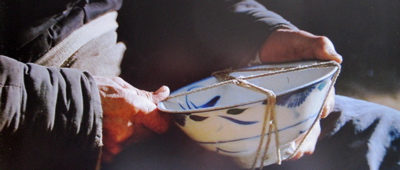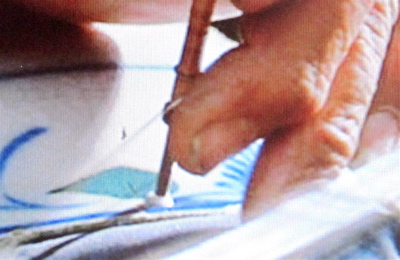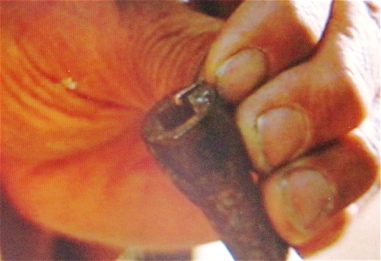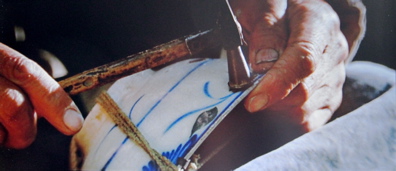I am frequently asked this question from people who see an object with staple repairs for the first time. I have spent many years gathering research to illustrate this fascinating topic and will try to demystify the skill and art of staple repair. Below are just a couple of examples but please know that I will be posting more photos and diagrams in the coming weeks.
This illustration, from “If These Pots Could Talk” by Ivor Noel Hume, shows a “nineteenth-century itinerant Chinese repairer using a bow drill and flanked by the work boxes he carried slung on a pole”.
Stills from the Chinese film “The Road Home” (1999) directed by acclaimed director Yimou Zhang (2008 Bejing Olympics, “House of Flying Daggers”, “Hero”) showing an itinerant pottery mender repairing a broken pot with staples. I highly recommend this film, as it clearly shows the entire repair procedure in a compelling 4 minute scene. If you view the DVD, the scene starts at 51:44 (chapter 15)
An itinerant mender, walking from town to town carrying his tools and supplies, shouts “Pottery repairs!”
Broken pieces of bowl are fitted together…
and held in place tightly with twine.
A wooden bow, with a diamond-tipped drill looped around a string, is pulled back and forth until a tiny hole is made in the bowl.
Drill close up
A small length of rigid brass wire is cut and hammered in to shape on the end of an iron mold
Staple close up
Finished staple is gently tapped in to the holes on the side of the bowl
Film stills courtesy of Sony Pictures, with Zhongxi Zhang as the “Crockery Repairman”









Thank you! Thank you! My curiosity has been quenched 🙂
I have a huge staple mended platter that came over in a container shipment from England about 30 years ago. The platter is in usable condition and I have served turkey and ham on it for several years. I am looking to sell it. I am wondering the best way to go about doing that.
Thank you,
Rebecca Moore
Oh no!!! I am going to have to try that now…I will see if a diamond covered jewelers drill will work. I assume I will need to use some water to cool the spot 🙂
hello Andrew! By any chance are you in the process of writing a book/price guide on riveted pottery? A vendor named Robert who has a pitch at the Lincoln and Newark antique market(U.K) has told me of an american man who collects stapled pottery and is writing a book. He was given a business card but he has misplaced it. I also have been collecting and selling these pieces for about 5 years through my shop. Reading your blog is illuminating and inspiring. I began collecting with no inspiration other than respect for the love of the art and the era of “make do and mend” that has been replaced with “Ikea” mentality. Too long to explain but I think you understand.
Discovering compatible souls is very gratifying. I certainly have regretted selling some items but I enjoy educating my clientele and perhaps slowly changing the perception of “need for perfection.” I recently attended the Newark, Lincoln and Peterboro shows and purchased a 1730 stapled Chinese bowl after my shippers had left so I had to hand carry it home via 4 days in Barcelona! It made it! I do hope to chat and maybe solve the mystery about the American man writing a book! cheers, Joy
Brilliant craftsmanship, and like Joy, good to know there are people who think this is still a valuable practice. Thank you, as I had no idea how it was done, and hope these craftsmen continue to get this valuable work directed toward them.
[…] Baseman’s thorough explanation of how china can be stapled is here. […]
Good afternoon, my name is maika and seeking markmy china I found your page which seems to me excellent
I have several dishes and plates with crown lion and unicorn and would like to have more information.
Excuse my English I’m using a translator.
I am Spanish.
a greeting
Maika
Hi Andrew,
I, too(re: joy), am interested in what writing exists or has the potential to exist on this topic. If you or someone you know is or is interested in writing further on this topic for print publcation, please contact me (editor@studiopotter.org). I edit a semi-annual print publication: The Studio Potter; our theme for Summer 2015 is “surface.” I think this topic would be a good addition to that issue.
Thanks,
Elenor
Just want to subscribe to your blog….
Thanks Connie
Thank you, très intéressant !
Thank you for this information. I reposted on Facebook’s British Pottery and Discussion Group.
Your site and collections are amazing. Thank you for sharing your passion and information.
Evea Souza Newsom